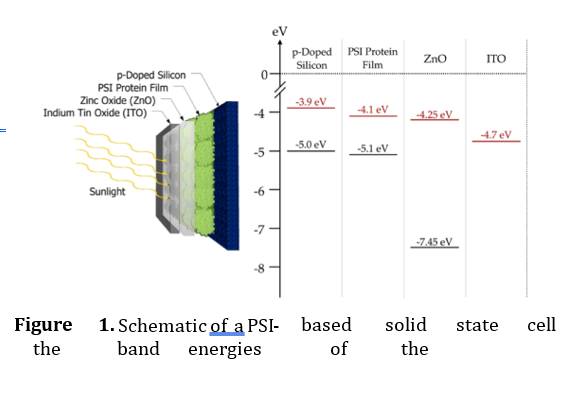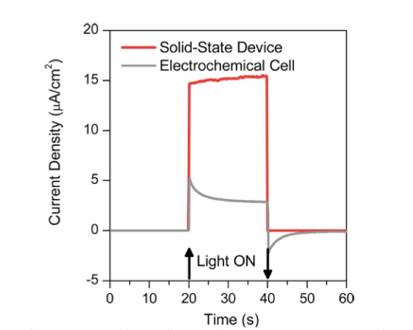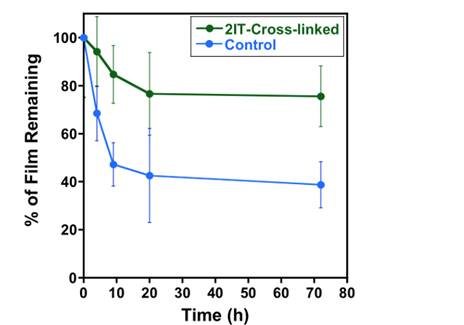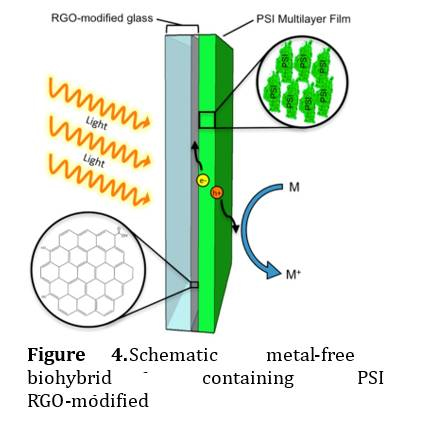Grantee Research Project Results
Final Report: Don't Eat Your Spinach: Nature Inspired Biohybrid Solar Cells
EPA Grant Number: SU835287Title: Don't Eat Your Spinach: Nature Inspired Biohybrid Solar Cells
Investigators: Jennings, G. Kane , Anilkumar, Amrutur V.
Institution: Vanderbilt University
EPA Project Officer: Hahn, Intaek
Phase: II
Project Period: August 15, 2012 through August 14, 2014 (Extended to August 14, 2015)
Project Amount: $88,992
RFA: P3 Awards: A National Student Design Competition for Sustainability Focusing on People, Prosperity and the Planet - Phase 2 (2012) Recipients Lists
Research Category: P3 Awards , P3 Challenge Area - Air Quality , P3 Challenge Area - Chemical Safety , Pollution Prevention/Sustainable Development , Sustainable and Healthy Communities
Objective:
Photosystem I (PSI)1is a photoactive, electroactive nanoscale protein complex that drives photosynthesis in green plants and cyanobacteria. During the past three years, the EPA P3 Phase II design team has focused on the preparation of a biohybrid solar cell in which a film of PSI protein complexes on a p-‐doped silicon electrode provide the ability to convert solar energy into electrochemical energy. The Jennings and Cliffel research team has shown that use of p-‐doped silicon (p-‐Si) as the working electrode enables electron transfer to (but not from) PSI proteins and remarkable 100-‐fold improvements over the use of gold as the electrode. This occurs due to band alignment between the p-‐Si and the PSI proteins so that p-‐Si acts solely as an electron donor to the PSI complex. The band gap of silicon is too high for electrons to be transferred from PSI back to the electrode. The ability to fabricate stable biohybrid solar cells with PSI and p-‐doped silicon could lead to tremendous improvements in cell performance over what the Phase I team demonstrated on gold electrodes. The 2012-‐13 team succeeded in optimizing the counter electrode (fluorine-‐doped tin oxide) and the mediator (ruthenium hexamine) and reducing the electrode separation to a few microns to based on the use of a Surlyn® spacer. The 2013-‐14 team employed an environmentally friendly mediator, began to address the instability of the silicon surface in the aqueous phase of a wet cell, and investigated vertical cell designs that mimic trees. However, these teams struggled in achieving long-‐term stability of the cells due to the rapid oxidation of silicon during cell operation. Achieving a more stable cell could represent major advances to this technology.>
Summary/Accomplishments (Outputs/Outcomes):
Figure 1. Progress During the 2014-‐15 Academic Year.Solid-‐State PSI Solar Cell. Prior work from our group has focused on wet photoelectrochemical cells in which PSI proteins were deposited onto p-‐Si and exposed to an aqueous solution of mediators to pull electrons away from the protein interface. These systems generated relatively large photocurrents due to the effective matching of the energy bands of p-‐Si with PSI. However, these wet photoelectrochemical cells exhibited tremendous drop in photocurrent over time due to the rapid oxidation of the silicon surface in an aqueous solution.
FIgure 2. Photochronoamperometric analysis of Si/PSI/ZnO solid
state (red) compared to a wet photoelectrical cell (gray).
During the last year of this project, we focused on fabricating solid-‐state p-‐Si/PSI devices that are more likely to maintain stable performance. In specific, we have employed PSI films deposited onto p-‐Si with a ZnO-coated ITO anode atop the PSI layer (Figure 1).2The selection of these materials was motivated by their band energies in which electrons flow downhill from p-‐Si through PSI to ZnO and to ITO (Figure 1). Figure 2 shows that the solid-‐state device yields a stable, slightly increasing photocurrent with time of irradiation whereas the wet photoelectrochemical cell exhibits a characteristic decrease in photocurrent with time due to the diffusional limitations. Also note that the 40 s current for the solid-‐state device is 5x greater than that for the wet cell due to the more rapid transfer of electrons through the solid-‐state system.
This device represents the second solid-‐state PSI-‐based biohybrid solar cell ever reported. Device testing revealed an external quantum efficiency of 0.008%, an open circuit potential of 214 mV, a short circuit current of 127 µA/cm2, and a fill factor of 0.28.2 The efficiency of this cell is at least an order of magnitude higher than the first reported PSI solid-‐state cell from a group in Europe in 2014 (seeAdv. Mater. 2014, 26, 4863).
Conclusions:
Figue 3. Loss of-cross-linked and -cross-linked control films of
PSI upon exposure solution of KCI (0.1 M) for the.
The solid-‐state cell also exhibited vastly improved stability over wet cells. Whereas wet cells lose more than two thirds of their power in the first 24 h due to rapid silicon oxidation in aqueous environments, the solid-‐state cell exhibited no degradation in current with intense illumination over 67 h. Devices operated each day for two weeks exhibited between 5 and 30% loss.2 The p-‐Si electrode is vastly more stable in a dry environment, and the PSI protein can indeed perform its biological function outside of a wet environment.
Cross-‐linking PSI for Improved Wet Cell Stability. One source of instability for wet PSI cells is desorption of individual proteins into the aqueous solution. We have successfully cross-linked PSI proteins in a thin film using 2-‐iminothiolane. These cross-‐linked films are more stable than non-‐cross-linked control films, as shown in Figure 3. While 60% of the non-‐cross-‐linked film desorbs from the surface in three days, only 20% of the cross-‐linked film is lost. This increased stability also leads to greater photoelectrochemical performance, as the cross-‐linked film was able to maintain its photocurrent over this exposure while the non-‐cross-‐linked control film exhibited a decreased photocurrent by over 50% from its initial state.
Figure 4. Schematic metal-free biohybrid containing PSI RGO-modified.
Metal-‐Free Biohybrid Electrode. In 2014, we reported a metal-‐free biohybrid electrode by depositing PSI onto a semi-‐transparent reduced graphene oxide (RGO) film on glass (Figure 4).3 The semi-‐transparency enabled us to illuminate the cell from either the top of the PSI film or through the RGO/glass electrode. We also employed dichloroindophenol as an environmentally friendly mediator. Metal-‐free systems such as these could impact the fabrication of inexpensive and environmentally sustainable solar cells for developing countries. The ability to extract PSI from a wide variety of green plants,4and not just spinach, can lead to its uber-‐abundance and affordability in these sustainable designs.
Journal Articles on this Report : 4 Displayed | Download in RIS Format
| Other project views: | All 4 publications | 4 publications in selected types | All 4 journal articles |
|---|
| Type | Citation | ||
|---|---|---|---|
|
|
Gunther D, LeBlanc G, Cliffel DE, Jennings GK. Pueraria lobata (Kudzu) photosystem I improves the photoelectrochemical performance of silicon. Industrial Biotechnology 2013;9(1):37-41. |
SU835287 (Final) |
Exit |
|
|
Darby E, LeBlanc G, Gizzie EA, Winter KM, Jennings GK, Cliffel DE. Photoactive films of photosystem I on transparent reduced graphene oxide electrodes. Langmuir 2014;30(29):8990-8994. |
SU835287 (Final) |
Exit |
|
|
LeBlanc G, Gizzie E, Yang S, Cliffel DE, Jennings GK. Photosystem I protein films at electrode surfaces for solar energy conversion. Langmuir 2014;30(37):10990-11001. |
SU835287 (Final) |
|
|
|
Beam JC, LeBlanc G, Gizzie EA, Ivanov BL, Needell DR, Shearer MJ, Jennings GK, Lukehart CM, Cliffel DE. Construction of a semiconductor–biological interface for solar energy conversion:p-doped silicon/photosystem I/zinc oxide. Langmuir 2015;31(36):10002-10007. |
SU835287 (Final) SU836022 (Final) |
Exit |
Supplemental Keywords:
photosynthesis, photoelectrochemical, siliconProgress and Final Reports:
Original AbstractP3 Phase I:
Don’t Eat Your Spinach: Nature Inspired Biohybrid Solar Cells | Final ReportThe perspectives, information and conclusions conveyed in research project abstracts, progress reports, final reports, journal abstracts and journal publications convey the viewpoints of the principal investigator and may not represent the views and policies of ORD and EPA. Conclusions drawn by the principal investigators have not been reviewed by the Agency.




